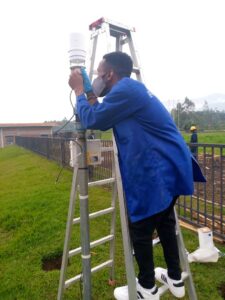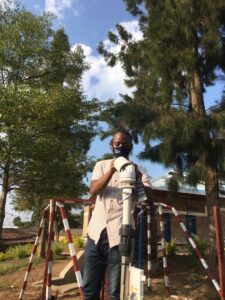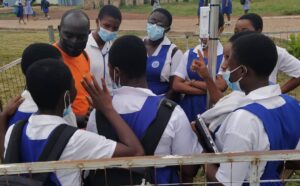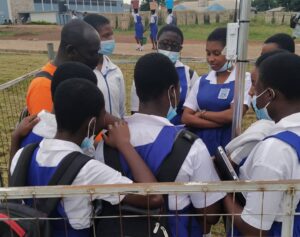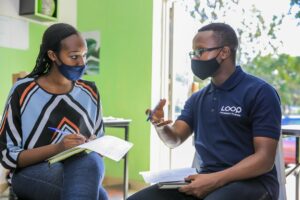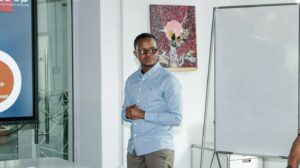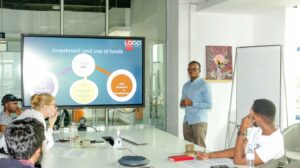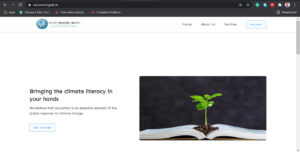All posts in Uncategorized
My name is Honore, and I am a Field Engineer at TAHMO here in Rwanda. My main work is to maintain the network of TAHMO weather stations and act as a representative of TAHMO here in Rwanda.
We have 16 Automatic Weather stations which are distributed in 4 Provinces. Most stations are in Kigali municipal and in the Northern Province.
I joined TAHMO in 2018. My initial goal then was to restore the transmission capacity of Rwandan Stations which had been offline for a while.
The culture at TAHMO has a way of elevating my execution capabilities; it emphasizes staff making decisions and following up with them. The culture also emphasizes planning and innovation. We also have a great support team among ourselves and the management.
Since March 2020 when COVID-19 hit Rwanda (and the world), I had to change a few things. It was difficult to work from home and hope to maintain a high rate of productivity. Now we use techniques like TeamViewer to maintain stations remotely. I also keep close contacts with the hosts of the weather stations who helps us troubleshoot minor issues.
I was the only TAHMO field engineer when I started. In 2020, I trained 2 volunteer assistant technicians; Jean and Elie. They have been working in northern and southern provinces. I am happy they have quickly adapted to TAHMO culture and are very helpful.
A School-2-school interactive event was held at St. Monica’s Senior High School at Asante Mampong in Ghana. The event was at a request of the host teacher who has just taken over the responsibility of the TAHMO Station.
It was a short and successful event. The opportunity was to provide students with the following:
- Brief background of TAHMO and its activities;
- TAHMO station – parts and how it works, type of data collected and access to the data;
- Importance of weather stations and climatic data; and the
- School-2-School Initiative.
The students and teachers were made aware of TAHMO and its activities. TAHMO operates 600+ Automatic weather stations on the African continent. These stations are located in 23 countries in Africa. TAHMO supports all the national meteorological agencies that it works with by providing access to its data.
TAHMO stations collect data for all the weather parameters – solar radiation (sunshine hours), rainfall, wind speed, wind direction, temperature, relative humidity, and atmospheric pressure. These sensors were pointed out to them as well as the data logger that stores and transmits the data.
Climate or weather data borders on security, as reliable and accurate data, help save the environment, lives, and properties. Weather-related disasters like flooding and drought impact can be minimized with accurate and reliable data. This will help provide adequate warning to the people in the affected region, area, or community ahead of the impending disaster. The students were made to understand and appreciate these as critical use of weather or climatic data.
The sch2sch Initiative is the platform designed to link or connect the schools that host TAHMO stations. To ensure this, access to the data from the station in the school is given, educational materials to support teaching and learning and regular interaction sessions are also provided. This is to ensure the station is not detached but facilitates learning at the school.
The TAHMO school-2-School program brings excitement as TAHMO host schools are informed, educated, and entertained on this platform.
St. Monica’s Senior High School is a single-sex (girls) school located at Asante Mampong in the Ashanti Region of Ghana. It is one of the top schools in the region and the country at large. It offers avenues for students to study science, business, and arts. The school became a TAHMO school in 2017 when it hosted a station.
Hi,
My name is Cyuzuzo Honore, a coordinator for TAHMO in Rwanda.
I had an idea of developing weather information service for student in Rwanda. The idea won me a grant.
It started at a challenging time in 2020: COVID-19 hit. In Rwanda, TAHMO activities (especially those that involved travelling) were disrupted. During the first months of COVID there was a lot of fear since only little information on the virus was available. But as days went by, these informations became available; we knew how to protect ourselves and eachother which reduced the fear we all felt at first. But still Rwanda – my country – was under travel restrictions.
Mid-August I got to know about LOOP ACCELERATOR – an incubation program for Education Startups. I have long had a vision to improve climate literacy in the younger generation. With motivation from TAHMO’s SCHOOL – 2 – SCHOOL program, I envisioned developing a climate information platform. My Idea was to was to develop a portal with this information, then add some climate change mitigation and adaptation skills on the online platform that will be accessible to Rwandan schools.
Severe Weather Consult, TAHMO’s sister company in Rwanda, has a platform called iHEWA, whose goal is to enhance accessibility of weather information services. Among the targets of the platform are the students – they interact, learn and experiment local weather data which enhances their knowledge on climate change mitigation and adaptation. We strongly believe education is an essential element of the global response to climate change.
I submitted my concept and it won a grant. I spent 3 months in Loop accelerator. It was great opportunity to share experience with other more than 10 startups in Education including some already in the market. It was also a milestone to let Rwanda ICT Chamber, GIZ, SMART Africa get to know what we are doing as TAHMO in closing the gap by providing accurate and efficient Meteorological data. In addition, Loop accelerator grant us 800 USD in total that helped us develop IHEWA Online platform (click to visit ihewa).
IHEWA will be as online library for climate literacy for young generation to start act on climate change action plan. Also, IHEWA will be like a tool for schools while they are teaching climate change mitigation and adaptation. A vast online platform that will be including climate science lesson plans, climate change mitigation and adaptation skills and climate change risk reduction tips.
Our paper, using TAHMO data, got published yesterday in ‘Progress in Physical Geography’
Abstract
In the Lake Kivu region, water erosion is the main driver for soil degradation, but observational data to quantify the extent and assess the spatial-temporal dynamics of the controlling factors are hardly available. In particular, high spatial and temporal resolution rainfall data are essential as precipitation is the driving force of soil erosion. In this study, we evaluated to what extent high temporal resolution data from the TAHMO network (with poor spatial and long-term coverage) can be combined with low temporal resolution data (with a high spatial density covering long periods of time) to improve rainfall erosivity assessments. To this end, 5-minute rainfall data from TAHMO stations in the Lake Kivu region, representing ca. 37 observation years, were analyzed. The analysis of the TAHMO data showed that rainfall erosivity was mainly controlled by rainfall amount and elevation and that this relation was different for the dry and wet seasons. By combining high and low-temporal resolution databases and a set of spatial covariates, an environmental regression approach (GAM) was used to assess the spatiotemporal patterns of rainfall erosivity for the whole region. A validation procedure showed relatively good predictions for most months (R2 between 0.50 and 0.80), while the model was less performant for the wettest (April) and two driest months (July and August) (R2 between 0.24 and 0.38). The predicted annual erosivity was highly variable with a range between 2000 and 9000 MJ mm ha−1 h−1 yr−1 and showed a pronounced east–west gradient which is strongly influenced by local topography. This study showed that the combination of high and low-temporal-resolution rainfall data and spatial prediction models can be used to improve the assessments of monthly and annual rainfall erosivity patterns that are grounded in locally calibrated and validated data.
Based in Chicago, Farm Immersive is a weekly blog by Peter Miller. His posts explore global food and agriculture innovations.
In a recent blog published on the 13th of April 2020, we got an honorary mention. In Peter Miller’s exact words “TAHMO is a bold project to build weather stations across Africa and share that data free of charge. This will greatly enhance all crop insurance modeling across the continent”.
want to read more on this beautifully written piece? click here
Due to the current COVID-19 situation, stations’ uptime might be affected. We are doing our best to maintain a very high uptime but remote stations could be affected due to restrictions on travel in these difficult times.
ENDEAVOR TO STAY SAFE
– Avoid public gatherings or crowds.
– Wash your hands with soap for at least 20 seconds when you come in from public areas or use an alcohol-based (more than 60%) sanitizer.
– If there are restrictions on movement in your locality, kindly heed them.
– Practice social distancing.

